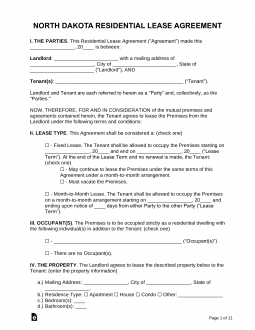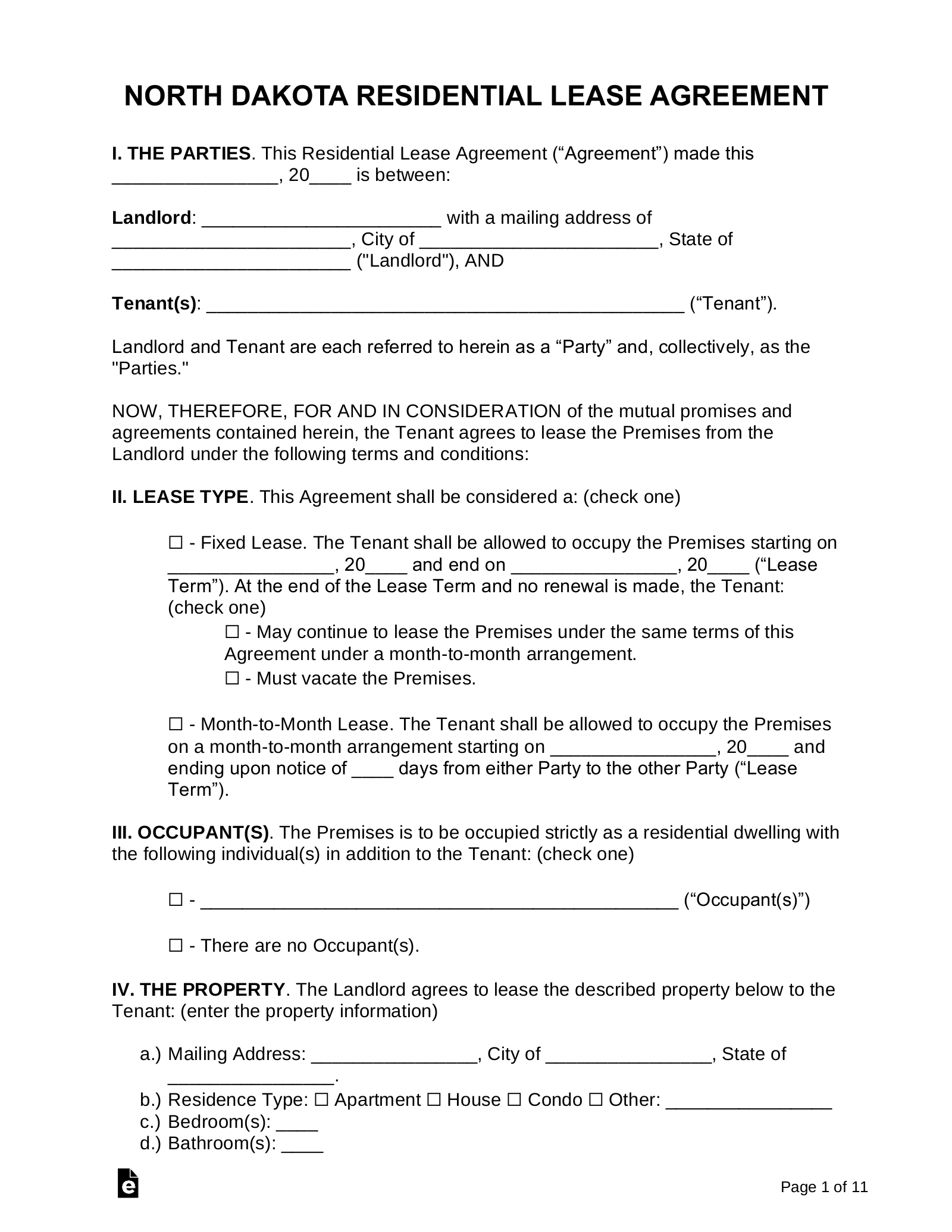Updated February 08, 2024
A North Dakota lease agreement is a rental contract between a landlord and tenant for commercial or residential property. In most situations, the prospective tenant’s credit and income will be verified by the landlord before signing the lease. When the lease is signed, the tenant typically must pay the first month’s rent and a security deposit.
Table of Contents |
Agreement Types (6)
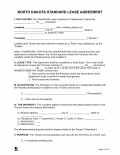 Standard Residential Lease Agreement – For a specified term usually lasting 12 months. Standard Residential Lease Agreement – For a specified term usually lasting 12 months.
Download: PDF, MS Word, OpenDocument |
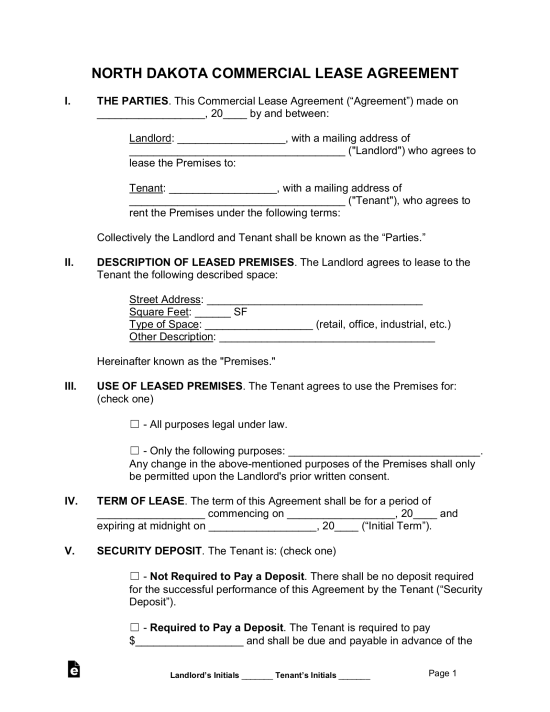 Commercial Lease Agreement – For the purposes of renting a property for business or professional use. Commercial Lease Agreement – For the purposes of renting a property for business or professional use.
Download: PDF, MS Word, OpenDocument |
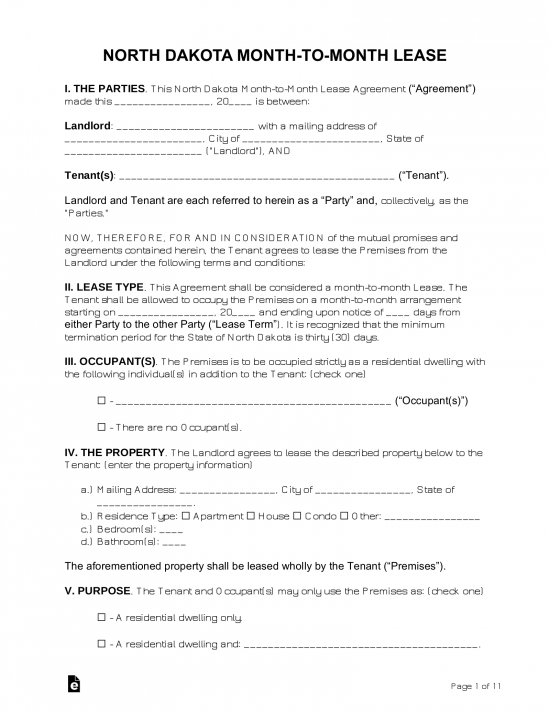 Month-to-Month Lease Agreement – Type of arrangement with a commencement but no end date. The landlord or tenant may terminate the document with at least 30 days’ notice. Month-to-Month Lease Agreement – Type of arrangement with a commencement but no end date. The landlord or tenant may terminate the document with at least 30 days’ notice.
Download: PDF, MS Word, OpenDocument |
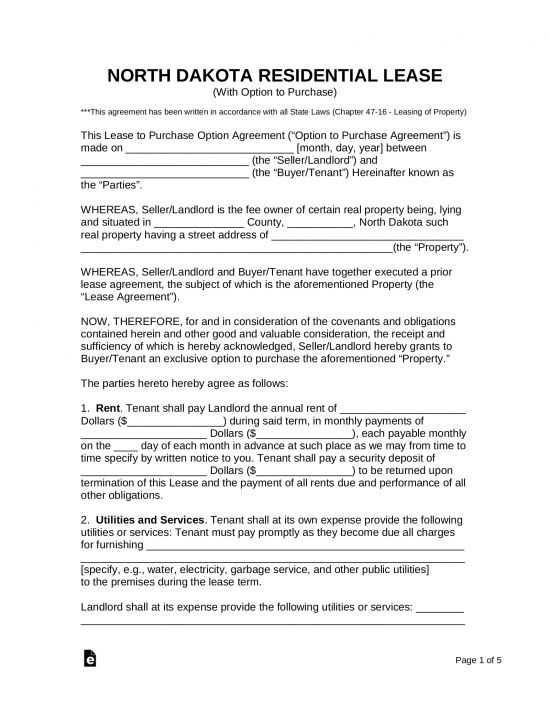 Rent-to-Own Lease Agreement – The tenant is given a chance to acquire the property in accordance with agreed-upon terms. Rent-to-Own Lease Agreement – The tenant is given a chance to acquire the property in accordance with agreed-upon terms.
Download: PDF, MS Word, OpenDocument |
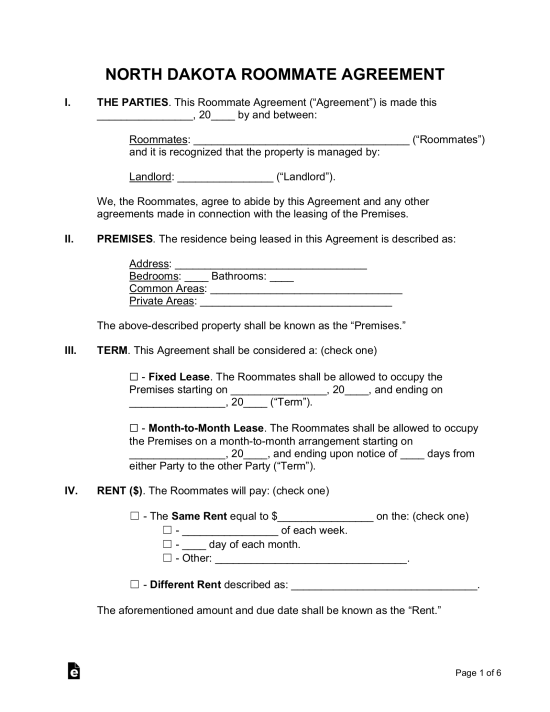 Room Rental (Roommate) Agreement – Designated for individuals sharing a residential dwelling with common space such as living rooms, kitchen areas, etc. Room Rental (Roommate) Agreement – Designated for individuals sharing a residential dwelling with common space such as living rooms, kitchen areas, etc.
Download: PDF, MS Word, OpenDocument |
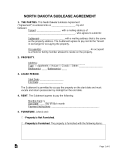 Sublease Agreement – The act of subletting which starts with a tenant who has an agreement with a landlord to re-rent space to another person known as the “subtenant.” Sublease Agreement – The act of subletting which starts with a tenant who has an agreement with a landlord to re-rent space to another person known as the “subtenant.”
Download: PDF, MS Word, OpenDocument |
Required Disclosures (2)
- Lead-Based Paint Disclosure – Federal law requires all landlords, property managers, and agents to disclose to any potential tenant the existence of lead paint in structures built before 1978.
- Property Condition Statement – The landlord must provide the tenant with an inventory checklist describing the current state of the premises and facilities. Both the landlord and the tenant must sign the statement.[1]
Security Deposits
Maximum Amount – A landlord can request up to two months’ rent from a tenant who has been convicted of a felony[2] or who has had a judgment against them for violating a previous lease.[3] For all other tenants, a landlord can request up to one month’s rent.[4]
Collecting Interest – The landlord must place the security deposit in a federally insured interest-bearing savings or checking account for the benefit of the tenant.[4]
Pet Security Deposit – A landlord can request up to two months’ rent or $2,500, whichever is greater, for a pet that is not considered a service animal or companion.[5]
Returning – The security deposit and any accrued interest must be returned to the tenant within 30 days of the end of tenancy.[6]
- Itemized List – If any portion of the security deposit is withheld to cover the costs of repairs, cleaning, or unpaid rent, the landlord must provide the tenant with an itemized list detailing how the withheld amounts were used.[6]
When is Rent Due?
Grace Period – There is no statutory grace period for the late payment of rent in North Dakota. If rent is not paid on the due date established in the lease, the landlord can send the tenant a three-day notice to quit.[7]
Maximum Late Fee – No maximum late fee is outlined in the state statutes. However, the landlord should include any late fees in the lease agreement.
NSF Fee – A landlord can charge up to $40 for a bad check written by a tenant.[8]
Withholding Rent – If the landlord has failed to make necessary repairs to the unit following notice from the tenant, the tenant can see to the repairs on their own and deduct the costs from the rent.[9]
Right to Enter (Landlord)
Standard Access – Unless impractical to do so, the landlord must give prior written notice before entering the premises for routine maintenance, for showings to prospective tenants or purchasers, or for any other legitimate reason.[10]
Immediate Access – The landlord may enter the property at any time during an emergency or if they reasonably believe the tenant is in substantial violation of the lease agreement or has abandoned the premises.[11]
Abandonment
Absence – There is no statewide statute or law in North Dakota that establishes a specific length of time a tenant must be absent for a rental property to be considered abandoned.
Breaking the Lease – A tenant may terminate the lease if the landlord has failed to fulfill their obligations regarding the upkeep and security of the property,[12] or if the tenant is a victim of domestic violence or in imminent danger of domestic violence.[13]
Tenant’s Utility Shutoff – If the tenant’s failure to maintain essential utilities on the property constitutes a material violation of the lease agreement, then the landlord may begin an action of eviction by serving a three-day notice to quit.[14]
Unclaimed Property – Any property worth less than $2,500 that has been left on the premises may be sold or otherwise disposed of by the landlord no less than 28 days after the tenant has vacated the unit.[15]

